
USC Dornsife report paints sobering picture of L.A. County’s social, economic conditions
The latest USC Dornsife-Union Bank LABarometer report, published Wednesday, examines affordability and prosperity in Los Angeles centered on housing, health care, food and education. It’s based on a survey of approximately 1,800 L.A. Country residents conducted Sept. 30 to Nov. 1, 2020.
The report’s key findings include:
- Housing: In L.A. County, 44% of renters are severely rent burdened, paying more than half their income to a landlord — much higher than the national average of 25% reported in a 2018 Harvard University study. A majority of renters — nearly two-thirds — spend more than the recommended 30% of their wages on housing. In contrast, less than a quarter of homeowners have a mortgage payment greater than 30% of their income.
- Health care: Many Angelenos are not getting the medical care they need, due in part to affordability. About 1 in 3 postponed or went without necessary medical care in 2020 because the cost was too high.
- Food: Food insecurity has declined substantially since the start of the pandemic, but about 1 in 9 adults — 870,000 Angelenos — continue to worry about having enough to eat.
- Education: Overall, about half of county residents rate the overall quality of their local schools as good or excellent. But Black parents are significantly less likely to send their kids to neighborhood schools, likely due to longstanding racial inequalities in access to high-quality public education.
It’s the first of what will be an annual report, conducted by the Center for Economic and Social Research(CESR) at the USC Dornsife College of Letters, Arts and Sciences.
“It comes as no surprise that L.A. is an expensive place to live, yet the extent and persistence of L.A.’s affordability crisis remains extraordinary,” said Kyla Thomas, director of LABarometer and associate sociologist at CESR. “The most basic need for millions of Angelenos is the ability to afford the cost of living in L.A. That’s been a longstanding challenge that has left many residents without a safety net, which is particularly problematic during times of crisis, like the ongoing pandemic.”
Manuel Pastor, director of the USC Dornsife Equity Research Institute, noted the pandemic’s role in highlighting societal challenges.
“COVID is the disease that has revealed our illness as a society: inadequate housing, stark divides by race and income, and a public health system in crisis,” said Pastor, Distinguished Professor of Sociology and American Studies and Ethnicity and Turpanjian Chair in Civil Society and Social Change. “This report is a dramatic picture of the challenges, including the stresses communities face with rent burdens, food insecurity and uneven access to health care. But it should also serve as a call to action to finally do something that recognizes that we cannot thrive as a region when so many find it hard to survive as families.”
The LABarometer report also highlights a range of racial disparities.
- Black and Latino Angelenos are disproportionately impacted by L.A.’s high cost of housing.
- Seventy percent of Latino renters are rent-burdened, as are 66% of Black renters. That’s compared to the 58% of whites and 52% of Asians who spend more than 30% of their income on rent.
- Among homeowners, Blacks are the most likely to be mortgage burdened; 38% pay more than 30% of their wages to pay off home loans, compared to 32% of Latinos, 20% of whites and 16% of Asians.
- About 12% of L.A. County renters moved in the last 12 months, and about 1 in 3 did so because of at least one issue associated with their landlord:
- Issues with the unit weren’t fixed – 21%
- Rent raised – 8%
- Legally evicted – 6%
- Told to leave – 2%
- Unit foreclosed – 1%
- Asian and Latino Angelenos were the least likely to seek medical care in 2020, and dental care was often what Angelenos skipped, due to cost.
- Just 50% of Asians visited a primary care doctor last year, compared to 67% of whites.
- 20% of Angelenos skipped dental care in 2020 because of the cost, compared to those who skipped:
- Vision care – 12%
- Prescriptions – 11%
- Specialty doctor – 9%
- Primary care – 9%
- Mental health care – 8%
About LABarometer
LABarometer is a quarterly, internet-based survey of approximately 1,800 randomly selected Los Angeles County residents, designed and administered by CESR and made possible by the generous support of Union Bank through a sponsorship agreement. The agreement is funded for 10 years, with plans to expand survey participation in L.A. County over the next few years to provide a more comprehensive understanding of the region.
The survey monitors social conditions in Los Angeles County, with a focus on four key issues: livability, mobility, sustainability and resiliency, and affordability and prosperity.
By following the same residents over time, LABarometer aims to capture trends and shifts in residents’ attitudes and circumstances, allowing decision makers in the public and private sectors to better understand the evolving lives and needs of L.A. residents.


